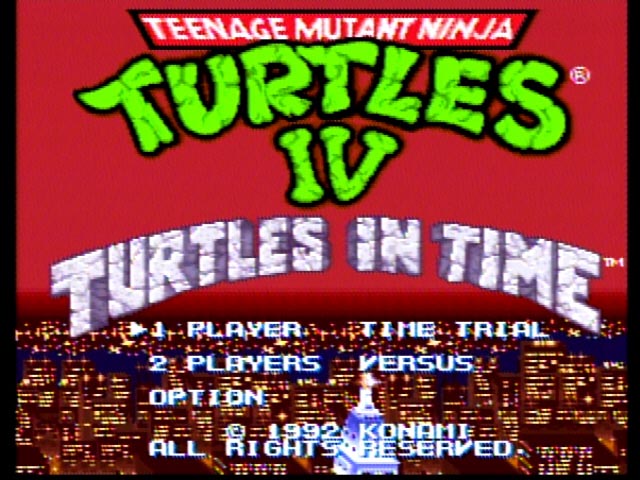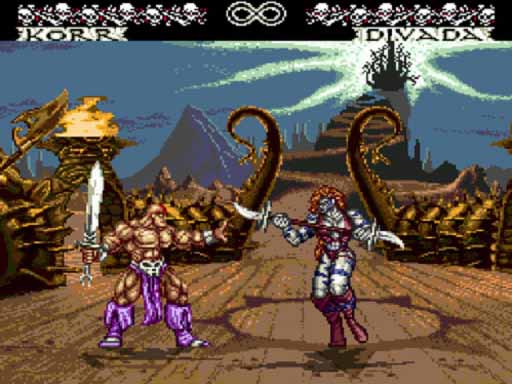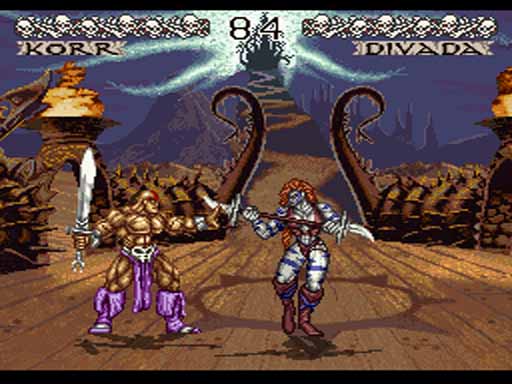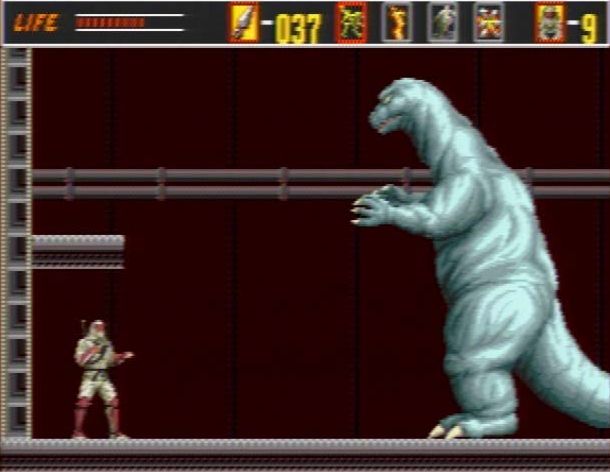| Golvellius: Valley of Doom | |
|---|---|
| System | Sega Master System |
| Publisher | Sega |
| Genre | Adventure |
| Region | North America |
| Release Year | 1988 |
| In Library | Complete |
| Teenage Mutant Ninja Turtles IV: Turtles in Time | |
|---|---|
| System | Super Nintendo |
| Publisher | Konami |
| Region | North America |
| Release Date | 8/1992 |
| In Library | Complete |
| Teenage Mutant Ninja Turtles: The Hyperstone Heist | |
|---|---|
| System | Sega Genesis |
| Publisher | Konami |
| Region | North America |
| Release Date | 12/1992 |
| In Library | Boxed |
Weaponlord - Genesis - SNES emulation comparison
Sun, 11/29/2009 - 20:04 — sheath- Read more
- 6900 reads
| WeaponLord | |
|---|---|
| System | Sega Genesis |
| Publisher | Namco |
| Region | North America |
| Release Date | 9/1995 |
| In Library | Complete |
Turbo DUO
Mon, 11/16/2009 - 01:38 — sheath| Lifespan: | 1992-1993 |
|---|---|
| CPU: | 7.16 MHz 8-bit HuC6280 3 |
| Audio: | 6 Channels (Uses CPU) 4 1 ADPCM Channel CD Audio |
| Co-Processors: | 3.58 Mhz PSG 5 Video Processor: 16-bit HuC6270 6 Color Processor: HuC6260 7 |
| Resolutions: | 256x256 || 320x256 8 |
| RAM | 8 KB |
| Video RAM: | 64 KB |
| CD RAM: | 256 KB (Super System Card 3.0) 2048 KB (2 MB Arcade Card) 9 |
| Colors On Screen: | 480 (60-90 Average, ~128 Max in games) 10 |
| Color Palette: | 512 ( 32 Palettes of 16 colors each) 11 |
| Sprite Max & Size: | 64 at 16x16, 16x32, 16x64, 32x16, 32x32, and 32x64 pixels 12 |
| Sprites per Scanline: | 16 13 |
| Background Planes: | 1 Layer (Dynamic Tiles and Sprites were used to create up to four scrolling layers) |
- 1. Jonathan J. Burtenshaw, ClassicGaming.com's Museum NEC TurboGrafx-16 (TG16) - 1989-1993 (archive.org February 1, 2008)
- 2. TurboGrafx-16/Duo FAQ - By John Yu, Last revised: 05/25/95 (archive.org May 14, 2007)
- 3. GAMESX.com Forums, Console Mods, RobIvy64 (e-mail) "TG-16/PCE overclocking success!" (archive.org May 1, 2008)
- 4. 6 Waveforms, 1 Frequency Modulated Channel leaves 4 Waveforms, 1 Waveform Channel can become White Noise, all channels can be programmed for sound samples. Paul Clifford (e-mail), PC Engine Programmable Sound Generator (psg.txt) (accessed February 18, 2010) available from http://www.plasma.demon.co.uk/pcengine/; internet.
- 5. Clifford, psg.txt $0802 - Fine frequency adjust
- 6. Emanuel Schleussinger, PC-Engine Video Display Controller Documentation (vdcdox.txt), (February 1998, accessed March 19, 2010) available from http://www.zophar.net/documents/pce.html; internet.
- 7. Paul Clifford (e-mail), PC Engine Video Colour Encoder (vce.txt)(accessed February 18, 2010) available from http://www.plasma.demon.co.uk/pcengine/; internet.
- 8. Typically only 216 horizontal lines are visible and are either 256 or 320 pixels wide, Schleussinger, (vdcdox.txt) 5. The Sprites in the VRAM.
- 9. Japan Only
- 10. Sixteen 15 Color palettes for the background, sixteen 15 Color Palettes for Sprites, Clifford, (vce.txt).
- 11. Clifford, (vce.txt).
- 12. Nimai Malle (e-mail), pce_doc Video Sprites (accessed March 20, 2010) available from http://emudocs.org/?page=PC%20Engine
- 13. Actual limit may be 8 due to 16 pixel wide sprites being aligned as 32 pixel sprites, Malle, pce_doc Video Sprites
- Read more
- 13180 reads
Sega Genesis vs Super Nintendo
Sun, 11/08/2009 - 19:42 — sheath
| Lifespan: | 1989-1996 |
|---|---|
| CPU: | 7.67 MHz 16/32-bit 680005 |
| Co-Processors: | 3.58 MHz Z80 (Audio/SMS): Can write to 68000's Work RAM6 Can access cartridge's ROM data7 Texas Instruments 76489 (PSG Audio): 4 Channels 8 Yamaha 2612 (FM Audio):9 6 Channels: One 8-bit Stereo Digital Audio Channel (DAC) replaces one FM channel 10 10 Audio Channels total Output Frequency: 52 kHz |
| Video Processing: | VDP Master System Compatibility 11 Hardware Shadow and Lighting 12 Direct Memory Access (DMA): Transfer Rate: 7.2 KB per 1/60th second13 |
| Resolutions: | 256x224, 320x224, 320x448 14 |
| Work RAM: | 64 KB |
| Video RAM: | 64 KB |
| Audio RAM: | 8KB |
| Color RAM: | 72 Bytes 15 |
| VSRAM: | 40 Bytes 16 |
| Colors On Screen: | 61 (30-75 in game, average 50) 17 18 |
| Color Palette: | 512 |
| Sprite Max & Sizes: | 80 sprites at 320x224 64 sprites at 256x22419 Sprite Sizes: 8x8, 8x16, 8x24, 8x32 16x8, 16x16, 16x24, 16x32 24x8, 24x16, 24x24, 24x32 32x8, 32x16, 32x24, 32x32 20 |
| Sprites per Scanline: | 20 at 320x224, 16 at 256x224 21 |
| Background Planes: | 2 layers with 16 colors per 8x8 pixel tile22 VDP handles scrolling as single planes, independently scrolling 8 line rows, and independently scrolling lines.23 Each 8 line row can can be displayed over or under others. 24 |
| Storage: | Cartridge up to 32 Mbit (4 MByte) Bankswitch method allows more than 32 Mbit of storage.25 |
| Lifespan: | 1991-1997 |
|---|---|
| CPU: | 3.58 MHz 16-bit 65c816 31 6502 Compatibility (unused) |
| Co-Processors: | SPC700 (Sound CPU) S-DSP (Sound Generator) 8 Digital Audio Channels Independent Stereo Panning (per channel)32 Filters for audio smoothing and echo 33 Compressed audio decoding 34 Output Frequency: 32 kHz |
| Video Processing: | PPU 1 PPU 2 (On the same chip) 35 Mozaic/Pixelation DMA Transfer Rate: 5.72 KB per 1/60th second shared by 8 Channels 36 HDMA Used for per line updates 37 |
| Resolution: | 256x224, 256x448, 512x224, 512x448 38 |
| Work RAM: | 128 KB |
| Video RAM: | 64 KB |
| Audio RAM: | 64 KB |
| Sprite RAM: | 512 + 32 bytes 39 |
| Color RAM: | 512 Bytes 40 |
| Colors On Screen: | 240-256 41 42 (90-150 average in game) |
| Color Palette: | 32,768 |
| Sprite Max & Size: | 128 sprites at: 8x8 & 16x16, 8x8 & 32x32, 8x8 & 64x64, 16x16 & 32x32, 16x16 & 64x64, 32x32 & 64x64, 16x32 & 32x64, 16x32 & 32x32 43 |
| Sprites per Scanline: | 32, 34 8x8 tiles, 256 sprite pixels per line 44 |
| Background Planes: | Eight Modes Numbered 0 - 7 4 (96-colors, 24 per background, 3/tile) 3 (two 120-colors, one 24-colors) 2 (120-colors) 2 (240-colors, 120-colors) 2 (240-colors, 24-colors) 2 (120-colors, 24-colors, interlaced) 1 (120-colors, interlaced) 1 (255-color, scaled, rotated, etc) 45 |
| Storage: | Cartridge up to 32 Mbit (4 MByte) • Tales of Phantasia (1995) (48 Mbit) • Star Ocean (1996) (48 Mbit) Average: 8 Mbit ('91), 16-32 Mbit ('92-'97) |
- 1. Sam Pettus, "SegaBase Volume 3 - Megadrive / Genesis 'Sega MK-1601'," (January 23, 2007, accessed March 31, 2010) available from http://www.eidolons-inn.net/ (archive.org November 7, 2007).
- 2. Samuel N. Hart, A Brief History of Home Video Games: Sega Genesis, Geek Comix (archive.org June 16, 2008).
- 3. Legacy Sega Consoles: Sega Genesis, Sega of America (archive.org December 8, 2002).
- 4. PC Vs Console - Console Specs (4th Generation), (archive.org March 15, 2008).
- 5. Up to 32-bit processes internally, 16-bit data bus, Programer's Reference Manual M68000PM/AD Rev.1.
- 6. Are we sure MD Z80 can't write to M68K RAM? NCS does it....
- 7. Sega Genesis Manual.
- 8. 3 tone generators and 1 white noise, "Nemesis," GENESIS Technical Overview 1.00, (accessed April 1, 2010), 119.
- 9. Frequency Modulation is synthesized audio like PSG but considerably more complex.
- 10. Must be timed correctly in software to allow 5 FM Channels to play with digital audio (Street Fighter II:CE plays multiple digital audio channels simultaneously), "Nemesis," GENESIS Technical Overview 1.00, 92.
- 11. Charles MacDonald, E-mail || Homepage, Sega Genesis VDP documentation Version 1.5f (genvdp.txt) $01 - Mode Set Register No. 2, (August 10, 2000, accessed March 11, 2010), available from http://emudocs.org/?page=Genesis; internet.
- 12. MacDonald, genvdp.txt, 16.) Shadow / Hilight mode.
- 13. Speed at which data in RAM can be transferred to VRAM,"Nemesis," GENESIS Technical Overview 1.00, 45.
- 14. Interlaced double resolution mode, used in Sonic 2 splitscreen 2-player.
- 15. 64x9 bits, MacDonald, genvdp.txt, 9.) CRAM.
- 16. Vertical scroll RAM, 40x10 bits, MacDonald, genvdp.txt, 10.) VSRAM.
- 17. four 15-color palettes plus one background color
- 18. Direct 9-bit RGB (512 colors) available at half horizontal resolution, 160x224 or 128x224 visible, "Oerg866," "Nemesis" and "Chilly Willy," "Direct Color Demo using DMA," SpritesMind.net, accessed March 1, 2013, http://gendev.spritesmind.net/forum/viewtopic.php?t=1203.
- 19. MacDonald, genvdp.txt, 15.) Sprites
- 20. "Nemesis," GENESIS Technical Overview 1.00, 13.
- 21. MacDonald, genvdp.txt, Sprite Drawing Limitations.
- 22. Each tile shares colors from four 15 color palettes between the background and sprite layers, MacDonald, genvdp.txt, $0B - Mode Set Register No. 3.
- 23. MacDonald, genvdp.txt, $0B - Mode Set Register No. 3.
- 24. Hardware function of the VDP, MacDonald, genvdp.txt, 14.) Priority.
- 25.
"THE BANKSWITCHING MECHANISM",
SSFII GENESIS TECHNICAL INFORMATION. - 26. Samuel N. Hart, A Brief History of Home Video Games: Super Nintendo Entertainment System, Geek Comix (archive.org February 7, 2008).
- 27. Nintendo - Super NES - Detailed Specs, Nintendo of America (archive.org June 27, 2001).
- 28. PC Vs Console - Console Specs (4th Generation), (archive.org March 15, 2008).
- 29. Usenet, Rec.Games.Video, Ralph Barbagallo, SNES Hardware (January 19, 1992, accessed April 2, 2010) available from http://groups.google.com; internet.
- 30. Super NES Programming/SNES Specs, (October 29, 2007, archive.org June 14, 2008) available from http://en.wikibooks.org/wiki/Super_NES_Programming/SNES_Specs.
- 31. 1.56 MHz or 2.68 MHz in some software, Hardware.txt, available from http://www.mit.edu/afs/athena/activity/p/peckers/Programs/snes9x/solaris..., 65c816
- 32. SPC-700 Programming Information.
- 33. Anomie's S-DSP Doc version WIP (e-mail) (apudsp.txt), (October 13, 2005, accessed April 8, 2010).
- 34. "Ledi" and "Peekin", Super Famicomm Sound Manual NOA-SFX-04/15/90 (sfsound.txt), (October 15, 2001, accessed April 9, 2010), available from http://www.emudocs.org/?page=Super%20NES.
- 35. PPU is is called a single processor in all other documentation, Kevin Neviksti, SNES memory map and MAD-1 chip information (SNES_MemMap.txt), (accessed April 23, 2010) available from http://gatchan.net/uploads/Consoles/SNES/Flashcard/SNES_MemMap.txt.
- 36. 2.68MB divided by 8 (channels) divided by / 60 (frames per second), DMA occurs during VBLANK, Super NES Programming/SNES Specs, Direct memory access unit.
- 37. Uses DMA channels, Hardware.txt, H-DMA
- 38. 448 and 478 line modes are interlaced, Qwertie, Combined Registers Document (combined.txt), Screen mode/video select register [SETINI] (accessed on April 8, 2010).
- 39. Super NES Programming/SNES Specs, Video RAM.
- 40. Each color uses 2 bytes, David Piepgrass, Qwertie's SNES Documentation Plus DMA Revision 6 (2.1), Color Palettes, (1998, accessed April 5, 2010) available from http://emudocs.org (archive.org July 12, 2007).
- 41. eight 15 color background palettes, eight 15 color sprite palettes in most common graphic modes,
Charles MacDonald, E-mail || Homepage, SNES hardware notes (snestech.txt), CGRAM, (September 17, 2003, accessed March 11, 2010), available from http://www.emudocs.org/?page=Super%20NES - 42. 2048 Colors are technically possible using Direct Color Mode, Hardware.txt, Direct Colour Mode.
- 43. snestech.txt, Sprites
- 44. Super NES Programming/SNES Specs, Maximum onscreen objects (sprites).
- 45. 4 backgrounds limits colors per tile (8x8 pixels) to 3-colors whereas other modes are 15-colors per tile, adapted from Qwertie's SNES Documentation, Register $2105: Screen mode register (1b/W).
- Read more
- 93270 reads








